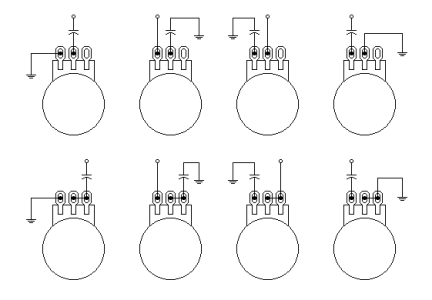Inflames626
New member
Hi everyone,
So I have some questions that I think are pretty basic and foolish here but I want to make sure I'm clear on this.
I'm not yet at the point where I can look at a wiring diagram and think of 2-3 different wiring layouts to accomplish the same thing, but you all are helping me get there via your helpful comments on the forums. Thank you.
Until I'm better at things, I tend to look at wiring diagrams very literally because I don't understand how I can deviate from them and still be successful.
With that in mind, I see on a lot of diagrams that the tone pot is not grounded to itself. One lug is usually left alone, while there's great variability regarding cap placement.
1) If a tone pot is used as the main ground hub instead of a volume pot (because on many guitars the tone pot is closest to the output jack), ***does the tone pot need to be grounded to itself for the guitar to work?***
I've been trying to wire up a guitar with the tone pot used as the main grounding point and I can't get it to work. No output at all. I thought perhaps the pot not being grounded to itself might be the cause. However, the cap also being in the equation made me think this might be different than using a volume pot as a grounding point.
A secondary question that I don't think deserves its own thread:
2) If a tab breaks off of a pot (say from twisting and moving with pliers to better accommodate connections), is the pot still usable if the wire is soldered to what remains of the terminal?
It's my understanding that the circular holes behind the pot tabs are heat sinks. However, I thought if a wire were soldered further behind this, the pot might be usable.
I think it would be more trouble than it's worth because solder could get into the pot and onto the wiper if a wire is soldered very close to the pot body, but I only have a few linear pots.
I can always order more but if the one with the broken tab can be salvaged I'd still use it.
So I have some questions that I think are pretty basic and foolish here but I want to make sure I'm clear on this.
I'm not yet at the point where I can look at a wiring diagram and think of 2-3 different wiring layouts to accomplish the same thing, but you all are helping me get there via your helpful comments on the forums. Thank you.
Until I'm better at things, I tend to look at wiring diagrams very literally because I don't understand how I can deviate from them and still be successful.
With that in mind, I see on a lot of diagrams that the tone pot is not grounded to itself. One lug is usually left alone, while there's great variability regarding cap placement.
1) If a tone pot is used as the main ground hub instead of a volume pot (because on many guitars the tone pot is closest to the output jack), ***does the tone pot need to be grounded to itself for the guitar to work?***
I've been trying to wire up a guitar with the tone pot used as the main grounding point and I can't get it to work. No output at all. I thought perhaps the pot not being grounded to itself might be the cause. However, the cap also being in the equation made me think this might be different than using a volume pot as a grounding point.
A secondary question that I don't think deserves its own thread:
2) If a tab breaks off of a pot (say from twisting and moving with pliers to better accommodate connections), is the pot still usable if the wire is soldered to what remains of the terminal?
It's my understanding that the circular holes behind the pot tabs are heat sinks. However, I thought if a wire were soldered further behind this, the pot might be usable.
I think it would be more trouble than it's worth because solder could get into the pot and onto the wiper if a wire is soldered very close to the pot body, but I only have a few linear pots.
I can always order more but if the one with the broken tab can be salvaged I'd still use it.

